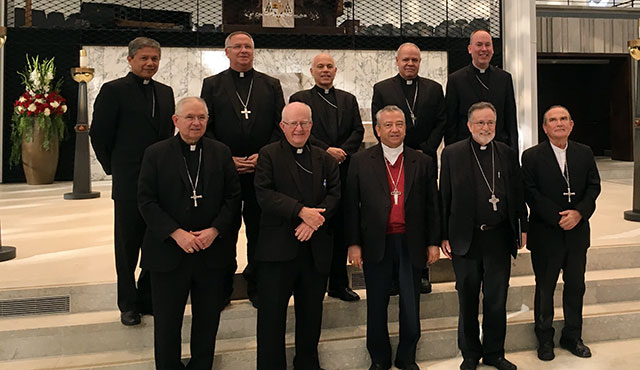With Christ Cathedral still glittering in newness, it was at the top of the list of bishops from Baja, Mexico as the site for the third annual “Encuentro de los Obispos de Alta y Baja California” or Meeting of the Bishops of Alta and Baja California.
“There was a strong desire from the other bishops, especially the ones from Baja,” said Bishop Timothy Freyer, auxiliary bishop of the Diocese of Orange, of their interest in seeing the new cathedral. “They had heard so much about it, they were looking forward to it. Bishop Vann gave a great tour.”
This year’s installment of the annual meeting, which was revived in 2017, was attended by clerics from Sacramento to Ensenada. Representatives from seven dioceses and archdioceses from the state of California, plus Tijuana, Mexicali and Ensenada from Mexico, and the California Catholic Conference were on hand.
After sightseeing, the attendees, who represent more than 13 million Catholics, got down to the business of the two-day meeting, held on Oct. 21-22 on the Christ Cathedral Campus.
“We share a lot of similar concerns and interests,” said Bishop Freyer. “We’re taking time to get to know one another.”
The meetings were resumed in response to Pope Francis’ visit to Mexico, where he urged the bishops from Mexico and the United States to work together, particularly with the ongoing issues at the border and families split between the countries.
“Many of our people have family in Baja,” Bishop Freyer said.
During six hours of meetings, the church leaders discussed a wide spectrum of issues. One session that proved valuable was a discussion with leadership from Immigration and Customs Enforcement, according to Bishop Freyer.
“We’ve had good discussions with them in the past,” he said.
ICE officials described what they do, enforcing immigration throughout the U.S., and how it differs from U.S. Customs and Border Protection, which patrols the border area.
While Bishop Freyer said the diocese has “had good discussions with (ICE) in the past,” the recent meeting gave the Baja contingent a chance to interact with the United States agency.
Related to that discussion were talks on providing services to immigrants on the border.
The church leaders also spent time talking about the continuing “abuse crisis,” Bishop Freyer said, and keeping children safe.
“We share similar struggles and challenges,” he said. “We shared best practices and continued to build fraternal relationships.”
The group also discussed support of the March 4th statement of the Texas and Mexico Border Bishops, decrying the Trump Administration’s “Remain in Mexico” policy.
The Tex-Mex statement read in part: “…we express our total disagreement with the policy of the government of the United States to send to Mexico migrants who are waiting for their turn to appear before a U.S. judge who will decide whether or not they receive asylum.”
Many of the challenges faced by the Alta-Baja prelates have national import. The issues the Alta-Baja clergy discussed were echoed three weeks later, on Nov. 11, at the United States Conference of Catholic Bishops general assembly.
Cardinal Daniel DiNardo, outgoing president of the U.S. bishops, highlighted the need throughout the U.S. to “press ahead in the fight against clergy abuse and in defense of migrants.”
The first Alta-Baja meeting was organized and held in San Diego in the wake of Pope Francis’ call for greater coordination between U.S. and Mexican clergy. Going forward, the meetings will alternate between Baja and California. Last year’s meeting was in Ensenada.
Next year the Alta-Baja meeting moves back to Mexico, tentatively in early November in Loreto.
“This was the resurrection of Alta-Baja,” Los Angeles Archbishop José Gómez told the California Catholic Conference after the 2017 meeting.
The annual meetings had been held after the Treaty of Hidalgo of 1848, which ended the Mexican American War, but were discontinued in the early 2000s.
The Alta-Baja name refers to the areas on each side of the California-Mexico border. Alta means “higher” in Spanish and Baja is lower. The two areas were one territory until Alta California became part of the United States.
“I think it’s important to find new ways to help our people to grow in their spirituality and to grow in their missionary spirit,” Archbishop Gómez said after the 2017 meeting.
Other issues the groups have discussed in previous meetings are the North American Free Trade Agreement and Pope Francis’ calls to protect the environment and battle climate change.
“We’ve learned a lot,” Bishop Freyer said. “It’s good to hear different perspectives.”
The bishop added that the group has begun talking about including bishops from Arizona and possibly the much larger Tex-Mex bishops’ group, although Bishop Freyer said such a meeting will likely be farther down the road.
“We want to build this before making it a larger meeting,” he said.
One thing on which the bishops agreed was the beauty of the Diocese of Orange’s new home cathedral.
“They saw it is possible to take a modern building and make it a prayerful and peaceful place,” Bishop Freyer said.

